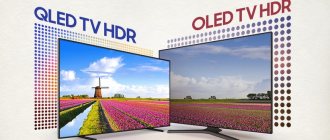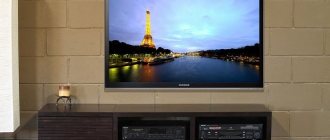Plasma TVs
Plasma TVs consist of a series of cones filled with gas. If you apply voltage to it, plasma is formed. A phosphor is applied to the walls of the cones, which converts the ultraviolet glow of the plasma into radiation of a certain color - red, blue or green.
Interesting! A plasma panel is a matrix of gas-filled cells, each of which is coated with a special phosphor, and their glow occurs due to the formation of plasma.
As a result, any of the possible shades is formed. A distinctive feature of plasma TVs is their high energy consumption and heavy weight.
Due to the technology, the problem of partial or complete burnout of pixels arises when a static picture is displayed for a long time - the phosphor on the bulbs burns out. Plasma TVs were at the origins of thin TVs. They are characterized by a fast matrix response and high contrast, so you get a bright and rich image.
Currently, the popularity of plasma panels is declining; they have been replaced by LCD and LED TVs.
How does a plasma TV work?
Advantages:
- deep and rich colors;
- low black level, such TVs produce black color as close to ideal as possible;
- high contrast;
- almost complete absence of matrix response time - this means that plasma is excellent for dynamic images, i.e. for films;
- wide viewing angles (170 degrees);
Flaws:
- high price;
- It is undesirable to include a static image, photographs, for example, for a long time. As we already mentioned, this harms the health of the pixels.
LCD TV
The phrase LCD display stands for “Liquid Crystal Display”, the synonym is LCD display. It consists of an LCD matrix, which in turn consists of two plates. Between them are liquid crystals. In addition to the matrix, the display design includes a backlight. Classic LCD TVs and monitors use CCFL backlighting - these are so-called cold cathode fluorescent lamps.
The backlight lamps are located at the end of the light-scattering layer of the matrix. The principle of operation is that liquid crystals located between two polarized plates change the polarization of light when a voltage is applied to them. The polarized plates between which the crystals are located have mutually perpendicular polarization. This means that light would not pass through these plates if there were no liquid crystals. Thus, by smoothly changing the polarization vector, you can change the intensity of light transmission through the matrix.
To obtain a color image, a color filter is applied to the cell. This is called a subpixel. There are red, green and blue subpixels. A group of subpixels of three colors is called a pixel. This part of the display is called a matrix because it consists of millions of such pixels.
The distinguishing feature of televisions in this group is their significantly lower weight and power consumption than plasma panels. Unfortunately, they have a lower viewing angle and contrast than plasma. The black color in LCD TVs is usually not completely black, but something between dark blue and dark gray tones. The response of the matrix is also lower than that of plasma panels. Manufacturers are using various technological tricks to improve the quality of LCD TVs.
Operating principle of LCD TV
Advantages:
- Relatively low cost;
- Great for displaying photos and other static information;
- Low power consumption;
- Service life up to 75,000 hours.
Flaws:
- High black level (closer to dark gray);
- Low contrast;
- Great response time.
Black level is measured in NT or nits, which is equal to 1 candela per 1 square meter of area. The lower the black level, the blacker the color.
What is LCD TV
LCD or so-called LCD monitors are two transparent electrode plates with liquid crystals between them. Such a system cannot emit light on its own; a cold cathode fluorescent lamp helps it do this. Longitudinal backlight beams are located behind the liquid crystal matrix, and are activated by applying electric current to them.
LED TV: advantages and disadvantages
Basically, LED TVs are LCD TVs. But instead of CCFL lamps, they have LEDs in the backlight. Due to this, energy consumption is further reduced. There are several options for LED backlighting:
- The placement of LEDs along the edge, the so-called Edge option. It is no different from CCFL backlighting. High contrast cannot be achieved. LEDs located around the perimeter of the screen shine on the light-diffusing glass, after which the liquid crystals transmit or do not transmit light. The problem is that closed (turned off) crystals still allow some light to pass through. Therefore, it is not possible to achieve depth of black;
- To solve this problem, we developed LED carpet backlighting for displays. This technology is called differently depending on the manufacturer, for example Full HD LED or LED pro. This technology allows for improved illumination uniformity, and individual diodes can dim their brightness to increase contrast and achieve a blacker color than with previous technology.
Advantages:
- acceptable, and in expensive models there is good image contrast;
- good color rendering;
- low weight;
- low power consumption;
- the use of LED backlight eliminates the high-voltage inverter for igniting lamps from the circuit. And it most often failed in CCFL LCD screens;
- LED TVs are thinner than LCD: the thickness of modern models reaches 4 mm.
Dynamic RGB direct backlighting in LED TV
The only significant drawback is the high cost of LED monitors and TVs, but recently this problem has been solved - there is a tendency for prices to decrease.
Comparative characteristics of LCD and LED TVs
When choosing a modern TV, the buyer is faced with a large number of questions, including what is the difference between LCD and LED TVs. After all, at first glance, these flat TV panels are no different. And the technology they use is the same - an LCD matrix consisting of two plates. Liquid crystals located between them, under the influence of electric current, like a camera shutter, transmit or block light. Depending on the level of applied voltage, an image is formed on the screen. However, each type of TV has its own characteristics that allow you to determine which one is better.
Types of LCD and LED TV matrices
Today the popular types are:
- IPS are currently installed mainly in LG TVs of the low and mid-price segment 3-6 series and Philips 4 and 6 series, as well as on Panasonic. With its help, the developers managed to achieve large viewing angles. Its disadvantage is a fairly high black level (approximately 0.16 nits) and a long response time;
- S-PVA, manufactured by Samsung. Installed on Samsung, Panasonic and Sony 7 and 8 series TVs. Features a low black level (from 0.05 to 0.1 nits). Viewing angles are smaller than IPS;
- UV²A - this type is manufactured by Sharp. Installed in top Philips and Sharp models. Their viewing angle is between S-PVA and IPS, and the black level is the lowest and deepest - from 0.02 to 0.06, which is comparable to the black level of plasma panels.
Construction of an IPS type panel Construction of a VA type panel
Comparative characteristics of LCD, plasma and LED TVs
For greater clarity, let's compare the distinctive features of each type of TV - LCD, LED, plasma.
- Screen size. Previously, due to the design features, plasma panels had large diagonals; currently, a number of diagonals start from 42″. LCD and LED TVs can be manufactured in any size. For example, mobile phone screens have been manufactured using these technologies for more than 15 years;
- Contrast. In the first place in this category are plasma panels, LED in second, and LCD in third, although for liquid crystal displays the type of matrix plays a big role in the image;
- Depth of black. This value is related to the contrast of the image; plasma technology is also in the lead, and in liquid crystal displays, LED TVs with carpet backlighting and a UV2A matrix have the maximum black depth;
Black depth is related to image contrast - Viewing angle. Plasma models have very good viewing angles (170 degrees). For LCD and LED displays, this parameter strongly depends on the type of matrix used; the largest angles are typical for IPS;
- Fast response. Plasma TVs are also leaders in this category; they have a minimum matrix response time of about 1 ms. LCD displays are characterized by values from units to tens of ms;
- Uniformity of screen illumination. Plasma TVs have uniform illumination due to the fact that each pixel is a light source. But with LCDs the situation is more complicated. Most often, the backlight is located at the ends of the screen, with the exception of LEDs with carpet backlighting. CCFL lamps provide fairly uniform light; it is diffused in a special layer of the screen. And LEDs located along the edge usually give good results, but it greatly depends on their number;
- Glare in the sun. Comfort when watching TV under direct or tangential sunlight is affected by two factors - backlight brightness and screen coverage. LCD TVs often have brighter backlighting than plasma TVs, and the same applies to TVs with LED backlighting, so they are more comfortable to watch in bright light. There are screens with glossy and matte anti-glare coating. Matte screens have a small drawback - they have slightly faded colors compared to glossy ones. But if the TV is placed opposite the window, then watching it under the bright rays of the sun will be nothing but torture. It is worth choosing the screen type individually;
Choose a TV based on its installation location - Screen burn-in. Screen burnout is most likely to occur when the plasma panel displays a static image for a long time. When working with dynamic content, all types of screens fully fulfill their service life;
- Energy efficiency. Today, LED TVs are the most economical in terms of energy consumption, LCDs occupy an intermediate position, and plasma panels consume the most in this comparison;
- Durability. The most durable are LCD and LED TVs, their service life reaches 100,000 hours. Although in fact this value is limited by the service life of lamps and LEDs - the matrix itself continues to work after replacing the backlight. A plasma panel has a lifespan of 30,000-60,000 hours. At the same time, this is the service life of the matrix itself, since it also plays the role of backlight;
- Price. LCD TVs are the cheapest, while plasma and LED TVs are the most expensive.
It is worth noting that low-quality CCFL backlight lamps can fade over time and produce worse light, the same applies to cheap Chinese LED products.
What is the difference between LCD and LED
As you can understand from what has been written, the main difference between LCD and LED TVs is the production technology. To understand what type of LCD panel to purchase, it is worth considering the following factors:
- Image. LED TVs are far ahead in this parameter. Their picture has better brightness, contrast and color rendition.
- Environmental friendliness. Due to the absence of mercury lamps, ice models win according to this criterion
- Energy efficiency. It is known that diodes consume significantly less electricity. But if you only use the TV in the evenings, the difference in energy consumption will be almost unnoticeable.
- Service life. LCD lamps burn out faster, while RGB diodes maintain accurate color reproduction much longer.
- Appearance. By their design, ice looks more attractive. They are much thinner and lighter
- Practicality. The new ones have more useful interfaces and connectors for interacting with other digital devices.
- The presence of smart devices is also more common among representatives from the LED segment.
- In addition to the variety of sizes, LEDs have two types of screens: straight and curved.
- If you plan to place the TV on the wall, then it is better to choose ice. It fits closer to the wall and looks more aesthetically pleasing.
Tips for choosing
All types of TVs are good in their own way; to choose a model that suits your needs, you need to decide what is your priority. The comparison above and these five tips from the experts will help you with this:
- If high contrast and deep colors are important to you, a plasma TV is perfect;
- For those whose TV works almost 24 hours a day or for use in public places, such as cafes and bars, an LED TV will be the best choice: they have a long service life and low power consumption;
- If the budget is very limited, but you want a large screen, then it is more profitable to purchase an LCD TV;
- Pay attention to the ability to play multimedia from a USB flash drive - this way you can save on purchasing an additional player;
- Access to the Internet via TV will make it easier for older people to learn new technologies, and will also be useful for those who have small children to play cartoons on Youtube.
Watch a video about which TV to choose











